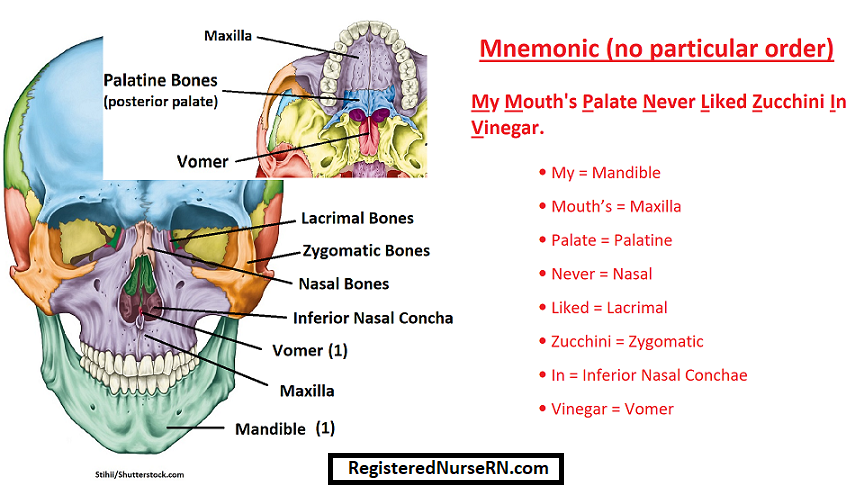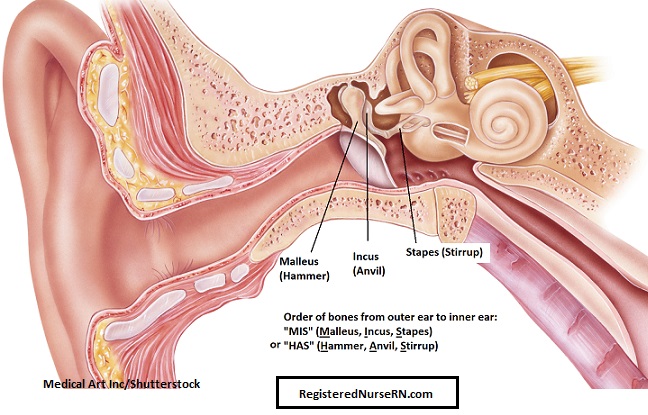In anatomy and physiology, you’ll learn about the 22 skull bones, which consists of flat and irregular bones that are connected together by jagged suture joints, making it look like creepy 3D jigsaw puzzle.
The 22 skull bones make up part of the axial skeleton, and they can be divided into two main sections: the 8 cranial bones, and the 14 facial bones.
Here’s a cool thing to remember about the skull bones: in the cranium, two bones come in pairs, but all the others are single bones. The facial bones are the complete opposite: you have two single bones, and the rest are pairs!
The 8 Cranial Bones
I’ll cover the eight cranial bones first, starting with the two pairs of bones.
- Parietal bones (2) – The first pair of bones in the cranium are the parietal bones. The word parietal sounds similar to “pair,” so that can help you remember that there are two of them. As I mentioned in my video on body cavities and membranes, the word parietal means wall, and these bones make up the walls on the side of the cranium.
- Temporal bones (2) – If you get a headache from studying anatomy, you might want to massage the sides of your temples to relieve the pressure. Guess what those paired bones are called? They’re called temporal bones! They are located just inferior (lower) to the parietal bones.
We already have four of the eight cranial bones, so we’re halfway there. All the rest of the cranial bones are single and ready to mingle:
- Frontal bone (1) – Look at your forehead. It makes up the FRONT of your cranium and also covers the frontal lobe of your brain. Guess what it’s called? It’s called the frontal bone. (Aren’t those anatomists so clever!) Forehead and frontal both start with an “F,” so this is probably the easiest cranial bone to remember.
- Sphenoid bone (1) – This butterfly-shaped bone articulates with all of the cranial bones and spans the entire width of the cranium, which you can see when you look at an inferior view of the skull. Many people think that it looks like a butterfly or bat, but it also looks like a specter (ghost). That’s how you can remember this cranial bone: the sphenoid is the specter that spans the cranium! Don’t be fooled by the lateral skull view, because it appears as though the sphenoid is another pair of bones, just like the temporal and parietal bones. However, the sphenoid is one large bone spans the cranium!
- Ethmoid bone (1) – “Ethmoid” comes from a word that means “sieve” or “strainer.” That’s because the top of this bone has something called cribriform plates that contains tiny holes, resembling a strainer. It’s located inferior to the frontal bone and between the sphenoid and nasal bones. When looking at the skull from the anterior view, you can see a part of it in the openings of the eye sockets and nasal cavity. However, it is mostly enclosed or encased within the skull. That’s how I remember this one: The ethmoid is the “enclosed” cranial bone.
- Occipital bone (1) – The word occipital literally means “back of the head.” It covers the occipital lobe of the brain, which processes visual images. It doesn’t make sense to a lot of people that our eyes are in the front of your head, yet the part of the brain that processes visual images is located in the back of the head. But it makes perfect sense to me, because I also happen to have eyes on the back of my head (bwahahaha).

Okay, we’re done with the cranial bones. Here’s a quick cranial bones mnemonic to help you remember them (from front to back, with the first two letters corresponding to the bone names): Ethan’s Fried Spanish Pasta Tempted Octavia.
- Ethan’s = Ethmoid
- Fried = Frontal
- Spanish = Sphenoid
- Pasta = Parietal
- Tempted = Temporal
- Octavia = Occipital
The 14 Facial Bones
There are fourteen facial bones, and all of them are pairs of bones except for two. I’ll cover those single facial bones first:
- Mandible (1) – The mandible is the jawbone. What facial feature do most girls say that they like about a guy? They want a guy to have a chiseled jawline, right? In other words, they want him to have a manly mandible. (It’s funny because the mandible is actually the strongest bone in your face, so even if you don’t have a strong jawline, at least you have a strong jawbone).
- Vomer (1) – this thin, flat bone forms the inferior part of the nasal septum, which is down the median plane of your nose. You can only see a small part of it when you look at the skull from the anterior view, because it extends deep into the skull. You can see it better when looking at the inferior view of the skull. It gets its name from an ancient word that means plowshare.
All the rest of these facial bones are pairs…
- Nasal bones (2) – The nasal bones are the easiest facial bones to remember, because they make up the bridge of the nose, and you should know where your nose is located. Nasal literally means related to the nose. If you get no other bone correct on your anatomy test, get the nasal bones right! They’re being handed to you.
- Inferior nasal concha (2) – These bones are easy to locate if you let the name help you. Inferior is a directional term that means “lower.” Nasal means related to the nose. And concha means shell-shaped. Put them together, and you’ve got shell-shaped bones in the lower part of the nose. Easy peasy!
- Lacrimal bones (2) – The lacrimal bones are also easy to remember. Have you ever seen someone with lacrimal fluid all over their face? Anatomy class can bring out your lacrimal fluid if you let it. Lacrimal fluid is another name for tears! Where are the lacrimal bones located? They are located right next to your tear ducts!
- Palatine bones (2) – How can you remember the palatine bones? Inside the roof of your mouth, you have a hard palate. That palate is hard because there are bones behind that tissue! The palatine bones make up the posterior palate! Palatine = posterior palate!
- Zygomatic bones (2) –The zygomatic bones are your cheekbones.
- Maxilla (2) – The maxilla, or maxillary bones, make up the maximum area of the face and articulate most all of the facial bones. That’s how you can remember these bones: Maxilla = maximum part of the face.

Here’s a quick facial bones mnemonic to help you remember them: My Mouth’s Palate Never Liked Zucchini in Vinegar.
- My = Mandible
- Mouth’s = Maxilla
- Palate = Palatine
- Never = Nasal
- Liked = Lacrimal
- Zucchini = Zygomatic
- In = Inferior Nasal Conchae
- Vinegar = Vomer
Associated Skull Bones
Some bones are not considered part of the skull, but they still reside in that general area. Therefore, they are often considered “associated” with the skull, so they deserve an honorable mention.
Ear Bones (Auditory Ossicles)
You have three ear bones (also called auditory ossicles) on each side, for a total of six ear bones. These three bones include (starting at the outer ear and moving toward the inner ear): the malleus (hammer), incus (anvil), and stapes (stirrup). You can remember “MIS” or “HAS” to help you keep the order correct (starting from the outer ear and moving toward the inner ear).

Hyoid Bone
Finally, you also have another bone associated with the skull, the hyoid bone. This bone is shaped like a “U,” and it doesn’t attach to any other bones in the skull. It is sometimes called the tongue bone because it is attached to the tongue and assists with swallowing.
Free Quiz and More Anatomy Videos
Ready to test your knowledge? Take our free (and quick!) skull bones quiz. Also, you might want to watch more of our anatomy and physiology lectures on YouTube, or check our anatomy and physiology notes.